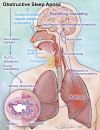Asthma and Obstructive Sleep Apnea Overlap: What Has the Evidence Taught Us?
- PMID: 31841642
- PMCID: PMC7258643
- DOI: 10.1164/rccm.201810-1838TR
Asthma and Obstructive Sleep Apnea Overlap: What Has the Evidence Taught Us?
Abstract
Obstructive sleep apnea (OSA) and asthma are highly prevalent chronic respiratory disorders. Beyond their frequent coexistence arising from their high prevalence and shared risk factors, these disorders feature a reciprocal interaction whereby each disease impacts the severity of the other. Emerging evidence implicates airway and systemic inflammation, neuroimmune interactions, and effects of asthma-controlling medications (corticosteroids) as factors that predispose patients with asthma to OSA. Conversely, undiagnosed or inadequately treated OSA adversely affects asthma control, partly via effects of intermittent hypoxia on airway inflammation and tissue remodeling. In this article, we review multiple lines of recently published evidence supporting this interaction. We provide a set of recommendations for clinicians involved in the care of adults with asthma, and identify critical gaps in our knowledge about this overlap.
Keywords: asthma; continuous positive airway pressure; obstructive sleep apnea; overlap; pathophysiology.
Figures


Comment in
-
Reply to Mehmood: Asthma and Obstructive Sleep Apnea: Taking It to Heart.Am J Respir Crit Care Med. 2020 Jun 1;201(11):1448-1449. doi: 10.1164/rccm.202001-0151LE. Am J Respir Crit Care Med. 2020. PMID: 32027805 Free PMC article. No abstract available.
-
Asthma and Obstructive Sleep Apnea: Taking It to Heart.Am J Respir Crit Care Med. 2020 Jun 1;201(11):1447-1448. doi: 10.1164/rccm.201912-2537LE. Am J Respir Crit Care Med. 2020. PMID: 32027809 Free PMC article. No abstract available.
References
-
- Young T, Palta M, Dempsey J, Skatrud J, Weber S, Badr S. The occurrence of sleep-disordered breathing among middle-aged adults. N Engl J Med. 1993;328:1230–1235. - PubMed
-
- Julien JY, Martin JG, Ernst P, Olivenstein R, Hamid Q, Lemière C, et al. Prevalence of obstructive sleep apnea-hypopnea in severe versus moderate asthma. J Allergy Clin Immunol. 2009;124:371–376. - PubMed
-
- Larsson LG, Lindberg A, Franklin KA, Lundbäck B. Symptoms related to obstructive sleep apnoea are common in subjects with asthma, chronic bronchitis and rhinitis in a general population. Respir Med. 2001;95:423–429. - PubMed
-
- Yigla M, Tov N, Solomonov A, Rubin AH, Harlev D. Difficult-to-control asthma and obstructive sleep apnea. J Asthma. 2003;40:865–871. - PubMed

